About a year before the 2005 groundbreaking for Trump International Hotel & Tower, Trump Organization executive Charles Reiss met the late Chicago real estate broker Bruce Kaplan and his colleague, Leslie Karr. The Trump family, Reiss said, wanted advice on how to market the retail space that would face the Chicago River at the tower’s base.
“The way it’s designed now, it’s never going to lease up,” Karr recalls telling Reiss. The roughly 70,000-square-foot deck’s 10-foot ceilings, undulating facade and sunken location would be too awkward to attract customers, she said.
Just reaching the space requires detailed directions. At the north end of the Wabash Avenue bridge, a tiled stairway dips down from the sidewalk and beyond the sight of passing pedestrians. Once you reach the bottom, the path gives way to a row of metallic columns rising like Sequoia trees five stories up to the hotel lobby, interrupting an otherwise unobstructed view of the river.
“It’s a dreadful space,” said Karr, who is now senior vice president for retail at SVN Chicago Commercial. “You could have some kind of luxury call center there, or maybe a high-end med spa, but not at the prices they were asking.”
A decade after the tower opened in 2009, it has just one retail tenant, a salon that occupies an enclosed 3,400-square-foot suite above the hotel lobby. The entire deck-level space remains empty, its blank beige walls on full display for the millions of tourists who stroll along the river each year. No part of it has ever been leased, according to Trump Organization tax appeal documents filed in Cook County and analyzed by The Real Deal.
Trump Tower’s failure is an outlier in Chicago’s competitive retail market, where no comparable space has languished on the market for nearly this long. Over the years, the Trumps have cycled through multiple leasing agents without success. Last year, the Trump name was even removed from marketing materials. And then added back again. Last summer, Donald Trump Jr. paid a visit to the property to kickstart leasing activity.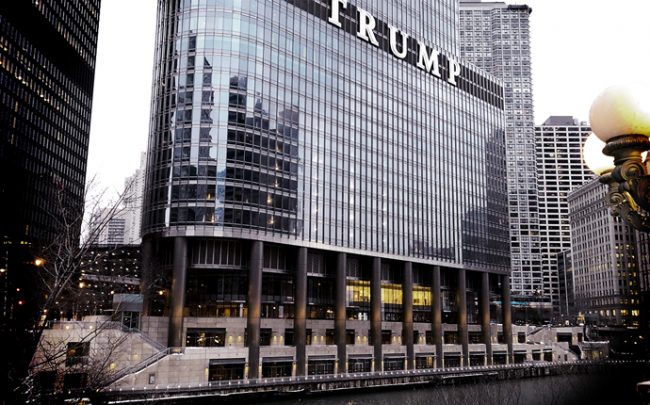
These efforts have proven futile: In 2018 alone, the tower’s leasing brokers, RKF and ARC Real Estate, spoke with at least 77 potential tenants — mostly cafe and restaurant operators — to discuss a potential lease, according to the tax appeal documents. All said no.
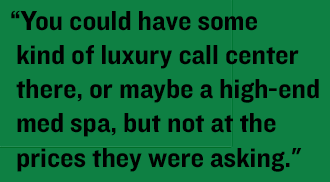
The Trump Organization did not respond to requests for comment for this story, nor did the city of Chicago’s Department of Planning and Development. The tower’s current leasing broker, ARC Real Estate, declined to comment.
In an interview Wednesday, Reiss, who left the Trump Organization in July 2004 and is now an independent new-development consultant, said he didn’t recall ever having met Karr. He said the retail space’s unconventional design was necessary to conform to the city’s zoning requirements, which mandated accessible space along the river.
“There was very little ground space,” he said. “Whoever Leslie Karr is, and however she’s trying to pat herself on the back, she wasn’t the only one saying it would be a challenge. Everyone said it would be difficult. But did we want a blank wall? Should the whole building have not been built because it was difficult? It was one floor of 90.”
A terrific loss
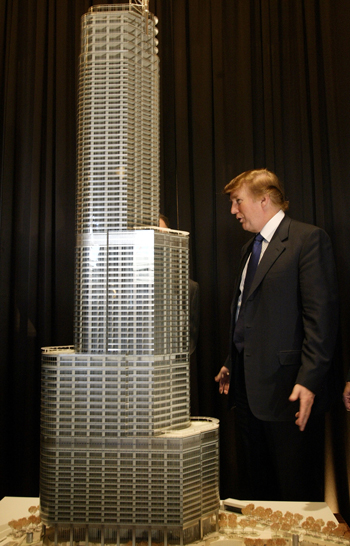
Donald Trump stands next to a model of Trump Tower Chicago in 2003
The lead architect for the tower, Adrian Smith, of Skidmore, Owings & Merrill, didn’t respond to a request for comment for this story. But in his 2007 book, “The Architecture of Adrian Smith, SOM,” he outlined his vision for the building.
The design of the retail portion “enables the structure to vary from Chicago’s north-south grid to create a special condition,” he wrote, adding that the building was shaped “to provide as many views up and down the river as possible.” Smith, who has since left SOM and runs his own architecture firm, also explained that the curving storefronts are meant “to eliminate any visual reflective distortion and to provide a metallic quality.”
When the 98-story hotel and condominium tower had just opened in 2009, the Trump Organization branded the double-deck riverwalk as “luxury retail” and sought net rents between $100 and $150 per square foot, according to multiple leasing brokers. That’s on par with outlets facing the Magnificent Mile, Chicago’s most glamorous stretch of shopping.
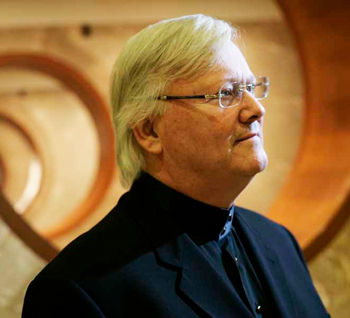
Architect Adrian Smith (Credit: Wikipedia)
CBRE, the first leasing brokers on the project, kicked off the marketing campaign by inviting high-end merchants to join one of the most trafficked shopping destinations in the country. The pitch didn’t land.
“We listened to all their bullshit about how great it was going to be…They were trying to pawn it off like it was part of Michigan Avenue,” said Paul Bryant, managing broker of Mid-America Real Estate. “We were like, no, it’s not.”
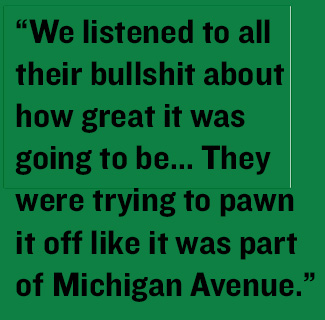
For now, the continued loss from the retail space mainly serves as justification for a lower property tax bill, the tax appeal documents show.
Last year, tax attorneys representing the developer estimated the space’s value at just $23.33 per square foot, citing average area rents from a 2018 CBRE report. The estimate is on par with second-floor retail leases in River North, or ground-level spaces in the Bronzeville neighborhood, Karr said.
Former Cook County Assessor Joe Berrios agreed to cut the property’s assessed value by about half last year, saving Trump about $500,000 in property taxes, county records show. Attorneys for the property appealed again, but the Cook County Board of Review did not grant another reduction.
According to their appeal to the board, brokers were in talks with five prospective tenants: two office users, a restaurant, a grocer, and a private school operator. The highest offers came from the office users, who discussed paying $40 per square foot in gross rent but ultimately didn’t sign. The grocer was in discussions to lease 28,000 square feet on the upper level at a gross rent of $30 per square foot but backed out. The restaurant group also walked away, saying it needed 22-foot ceiling heights.
More than 20 prospective tenants last year cited the space’s design or the location’s lack of visibility in their decisions not to sign a lease, the tax documents show.
“The common thread among these lost opportunities was that prospective tenants decided that the property’s layout, location, and or accessibility kept them from entering into a lease,” the Trump attorneys wrote.
But they added that brokers are now in “advanced negotiations” with a tenant that could take 67,700 square feet, or about 96 percent of the deck space.
The attorneys estimated the retail’s potential net revenue around $1.7 million for 2018. At that amount, the Trump Organization would have lost out on more than $17 million in potential revenue since the building’s opening. And if the building had ever leased at the $100-plus rents the Trump Organization once hoped for, the money left on the table is multiples of that.
The loss puts a sizable dent in the Trump Organization’s annual income for the tower, which President Trump reported in an ethics disclosure tallied $8 million in 2017.
“I wasn’t there for the lease-up,” Reiss said. “The retail would have been nice if it was rented. Why it wasn’t rented, I don’t know.”
‘A no-man’s land’
The decade-long vacancy sets a record for Downtown Chicago’s retail market in the modern era, according to Colliers International. No other retail site larger than 5,000 square feet has sat on the market for this long.
The next-longest vacancy, though, can be found next door to Trump Tower, where a 8,700-square-foot space at the Wrigley Building plaza had sat empty for more than nine years before chocolatier Ghirardelli leased it in 2014, following a $91 million renovation of the tower by then-owner BDT Capital Partners.
A 5,160-square-foot storefront has sat vacant at 871 North Rush Street since 2010, and a below-grade retail space has been empty since it was built in 2011 at 333 East Benton Place in the Lakeshore East area, according to Colliers.
The Benton Place spot and the Trump Tower deck share a key handicap: they can’t be directly accessed from the street. Sometimes that can be enough to stymie a property’s leasing efforts, according to Gregory Kirsch, head of Midwest retail for Cushman & Wakefield.
“Retail is all about location, and even the slightest nuance in placement can change everything,” Kirsch said. “If you’re just 200 feet off the avenue, that can bring your price down from $150 per square foot to $60.”
The Trump Tower retail space, Kirsch added, is especially hard to access.
“It’s a little like the Statue of Liberty,” he said. “It’s easy to see, but hard to get to.”
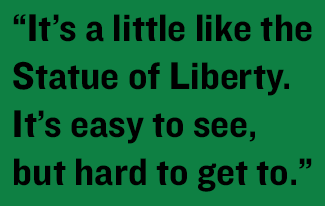
Mid-America’s Bryant agreed.
“The design, the location, how you get to it — it’s just a no-man’s land,” he said. “Retail is not that complicated, and the more complicated you make it, the worse it is.”
The design’s emphasis on outdoor deck space was also a miscalculation in a city where inclement weather keeps people indoors half the year, multiple brokers said. Consider that at the Riverwalk, a new city-owned esplanade on the south side of the river, several food-and-beverage vendors pay the city fees amounting to $10 per square foot or less, in a nod to their seasonal use, city contracts show.
The Not-So-Magnificent Mile
The Trump Tower retail space is among several underachievers in a Chicago submarket where vacancies are rising.
Beacon Tavern, a 4,200-square foot-seafood restaurant behind Trump Tower at 405 North Wabash Avenue, swells with tourists and office workers during happy hour most weekdays. At $65 a square foot in net rent, it’s been a boon for Mark Goodman, who owns the retail component of 405 North Wabash. But another 5,200 square feet of retail space inside the same building, which faces a grade-level plaza between Wabash and Michigan avenues, has sat vacant for at least a year.
Retailers aren’t faring much better around the corner on Michigan, Goodman said. Vacancies are piling up, now that e-commerce has taken the luster off what was once highly coveted real estate for outlet stores. Even for a visible retailer with an inviting design, the Magnificent Mile area is not as promising as it once was, he said.
“You have a bit of a bloodbath taking place in retail right now, and no one knows exactly where it’s going to go,” Goodman said. “Soft goods don’t know how to adapt, and it’s made it a very challenging environment.”
Merchants are hoping foot traffic picks up as new apartment and condo towers, like CIM Group’s redeveloped Tribune Tower and the supertall it plans next door, sprout up along the north branch of the river. Belgravia Group is now marketing its 50-unit Renelle on the River condo building just north of Trump Tower.
The new neighbors could be potential shoppers for the Trump retail deck, Belgravia principal Alan Lev said. But first, they would have to find it.
“Most of our residents just don’t even know it’s there,” Lev said. “I don’t think the vacancy is really hurting anyone, other than Trump.”
